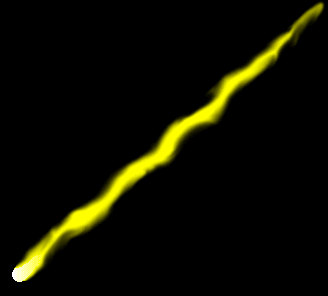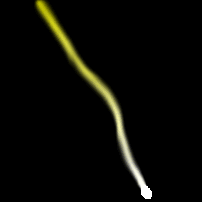

 Curved meteors are by far the most common. In some cases the cause is quite
simple: a meteoroid entering the atmosphere at an oblique angle will bounce
out again in much the same way as a pebble can be bounced across the surface
of a pond. There is actually photographic evidence of this happening. In
1972 James M. Baker captured a bright daylight fireball on film as it skipped
across the skies over Great
Jackson Lake in Wyoming. However, there are a number of observations
that cannot be explained so easily.
Curved meteors are by far the most common. In some cases the cause is quite
simple: a meteoroid entering the atmosphere at an oblique angle will bounce
out again in much the same way as a pebble can be bounced across the surface
of a pond. There is actually photographic evidence of this happening. In
1972 James M. Baker captured a bright daylight fireball on film as it skipped
across the skies over Great
Jackson Lake in Wyoming. However, there are a number of observations
that cannot be explained so easily.
One of the earliest reports came from B.J.Hopkins who recorded in the Monthly Notices of the Royal Astronomical Society (1885) that on 20th October 1879 at 18h 48m GMT he...
 Observed a bright yellow
meteor, which described a zigzag path with two bends.....Appeared between
Alpha and Beta Cameli, disappeared near Theta Persei.
Observed a bright yellow
meteor, which described a zigzag path with two bends.....Appeared between
Alpha and Beta Cameli, disappeared near Theta Persei.
It is difficult to explain how meteors can deviate in this way but one possible explanation may be that the meteoroid has an aerodynamic shape which produces "lift". Opponents of this view argue that most meteoroids are fragile dustballs rather than solid rocks - but that could be the very reason why such occurrences are rare.
Wavy and spiral meteors may be one and the same thing: it depends on how the observer perceives the object. But kinked meteors are almost certainly an optical illusion.

Like curved meteors, kinked
meteors begin normally but then suddenly develop a kink in their paths
before returning to their original trajectory. This may be due to a temporary
or permanent defect in the observer's eye (e.g. water on the eyeball) or,
as has been suggested, to water vapor in the atmosphere having a slightly
different refractive index to the surrounding air.